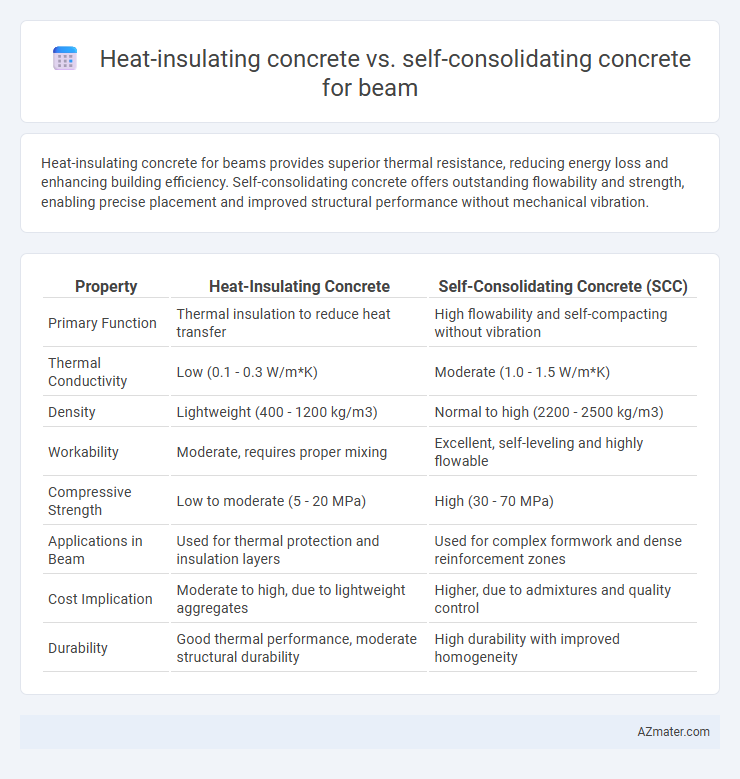Heat-insulating concrete for beams provides superior thermal resistance, reducing energy loss and enhancing building efficiency. Self-consolidating concrete offers outstanding flowability and strength, enabling precise placement and improved structural performance without mechanical vibration.
Table of Comparison
| Property | Heat-Insulating Concrete | Self-Consolidating Concrete (SCC) |
|---|---|---|
| Primary Function | Thermal insulation to reduce heat transfer | High flowability and self-compacting without vibration |
| Thermal Conductivity | Low (0.1 - 0.3 W/m*K) | Moderate (1.0 - 1.5 W/m*K) |
| Density | Lightweight (400 - 1200 kg/m3) | Normal to high (2200 - 2500 kg/m3) |
| Workability | Moderate, requires proper mixing | Excellent, self-leveling and highly flowable |
| Compressive Strength | Low to moderate (5 - 20 MPa) | High (30 - 70 MPa) |
| Applications in Beam | Used for thermal protection and insulation layers | Used for complex formwork and dense reinforcement zones |
| Cost Implication | Moderate to high, due to lightweight aggregates | Higher, due to admixtures and quality control |
| Durability | Good thermal performance, moderate structural durability | High durability with improved homogeneity |
Introduction to Heat-Insulating and Self-Consolidating Concrete
Heat-insulating concrete incorporates lightweight aggregates and insulation materials to reduce thermal conductivity, enhancing energy efficiency in beam applications by minimizing heat transfer. Self-consolidating concrete (SCC) features high flowability and passing ability without segregation, allowing for easy placement and filling of complex beam molds without mechanical vibration. Both concrete types optimize beam performance, with heat-insulating concrete focusing on thermal properties and SCC on workability and structural integrity.
Defining Beam Requirements in Modern Construction
Heat-insulating concrete for beams enhances thermal performance by reducing heat transfer, which is critical in energy-efficient building design. Self-consolidating concrete offers superior flowability and compaction, ensuring strong structural integrity and reduced labor in complex beam forms. Selecting the appropriate concrete type depends on balancing thermal insulation needs and structural strength requirements specific to modern construction projects.
Composition and Properties of Heat-Insulating Concrete
Heat-insulating concrete for beams commonly incorporates lightweight aggregates such as expanded polystyrene beads or perlite to reduce thermal conductivity while maintaining adequate strength. Its composition emphasizes low density and high porosity, resulting in enhanced thermal resistance and energy efficiency compared to conventional concrete. This type of concrete typically exhibits lower compressive strength and higher thermal insulation values (R-value), making it suitable for applications where heat retention and weight reduction are critical.
Composition and Properties of Self-Consolidating Concrete
Self-consolidating concrete (SCC) for beams features a carefully balanced composition with high cement content, fine aggregates, and superplasticizers that enhance flowability without segregation. SCC exhibits superior viscosity and filling ability, allowing it to flow effortlessly into complex formworks and around dense reinforcement, ensuring uniform compaction and eliminating the need for vibration. Its properties include high workability, reduced shrinkage, and improved surface finish, making it ideal for structural beams requiring rapid placement and high durability compared to traditional heat-insulating concrete.
Thermal Performance in Beam Applications
Heat-insulating concrete offers superior thermal resistance with lower thermal conductivity values, typically around 0.1-0.3 W/m*K, which effectively minimizes heat transfer in beam applications and enhances energy efficiency. Self-consolidating concrete (SCC), while excellent for flowability and structural performance, generally has higher thermal conductivity, approximately 1.4-2.3 W/m*K, resulting in less thermal insulation compared to specialized heat-insulating mixes. Optimizing beam thermal performance favors heat-insulating concrete due to its ability to reduce thermal bridging and maintain structural integrity under varying temperature conditions.
Structural Strength and Load-Bearing Capacity
Heat-insulating concrete offers enhanced thermal resistance but generally exhibits lower structural strength and load-bearing capacity compared to self-consolidating concrete (SCC). SCC provides superior compressive strength and improved uniformity, enabling better load distribution in beams without compromising formwork integrity. For beam applications requiring high structural performance, SCC is preferable due to its ability to achieve greater density and reduced porosity, directly impacting durability and load capacity.
Workability and Placement Efficiency
Heat-insulating concrete offers moderate workability with lightweight aggregates reducing thermal conductivity but may require vibration for proper compaction in beams. Self-consolidating concrete excels in workability and placement efficiency due to its high flowability and ability to fill complex beam forms without mechanical vibration. For beam construction where intricate reinforcement and formwork are present, self-consolidating concrete significantly enhances placement speed and surface finish quality.
Cost Comparison and Resource Efficiency
Heat-insulating concrete for beams typically incurs higher material costs due to specialized additives like expanded polystyrene or aerogels, enhancing thermal performance but increasing expense. Self-consolidating concrete, while potentially more expensive per cubic meter than conventional mixes, reduces labor costs through improved flow and placement efficiency, minimizing the need for vibration and formwork adjustments. Resource efficiency favors self-consolidating concrete by lowering construction time and waste, whereas heat-insulating concrete optimizes energy savings in the building lifecycle, balancing upfront investment with long-term operational cost reductions.
Durability and Long-Term Maintenance
Heat-insulating concrete provides superior thermal resistance and reduces temperature-related stress, enhancing durability in beam applications exposed to fluctuating climates. Self-consolidating concrete offers exceptional flowability and compaction, minimizing voids and cracks, which significantly improves structural integrity and reduces long-term maintenance needs. Both materials contribute to durability, but heat-insulating concrete excels in thermal protection while self-consolidating concrete ensures dense, defect-free beam construction for extended service life.
Best Use Cases: Choosing the Optimal Concrete for Beams
Heat-insulating concrete offers superior thermal resistance, making it ideal for beams in energy-efficient buildings or structures exposed to extreme temperature variations. Self-consolidating concrete excels in complex beam forms requiring high flowability and minimal vibration, ensuring dense, uniform fills in congested reinforcement areas. Selecting the optimal concrete depends on project-specific demands: thermal insulation prioritizes heat-insulating concrete, while intricate formworks or rapid placements benefit most from self-consolidating concrete.

Infographic: Heat-insulating concrete vs Self-consolidating concrete for Beam
 azmater.com
azmater.com